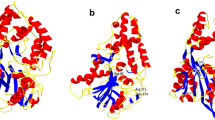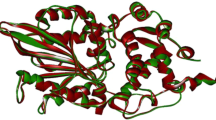Abstract
Phytases are used to improve phosphorus nutrition of food animals and reduce their phosphorus excretion to the environment. Due to favorable properties, Escherichia coli AppA2 phytase is of particular interest for biotechnological applications. Directed evolution was applied in the present study to improve AppA2 phytase thermostability for lowering its heat inactivation during feed pelleting (60–80°C). After a mutant library of AppA2 was generated by error-prone polymerase chain reaction, variants were expressed initially in Saccharomyces cerevisiae for screening and then in Pichia pastoris for characterizing thermostability. Compared with the wild-type enzyme, two variants (K46E and K65E/K97M/S209G) showed over 20% improvement in thermostability (80°C for 10 min), and 6–7°C increases in melting temperatures (T m). Structural predictions suggest that substitutions of K46E and K65E might introduce additional hydrogen bonds with adjacent residues, improving the enzyme thermostability by stabilizing local interactions. Overall catalytic efficiency (k cat / K m) of K46E and K65E/K97M/S209G was improved by 56% and 152% than that of wild type at pH 3.5, respectively. Thus, the catalytic efficiency of these enzymes was not inversely related to their thermostability.




Similar content being viewed by others
References
Cherry JR, Lamsa MH, Schneider P, Vind J, Svendsen A, Jones A, Pedersen AH (1999) Directed evolution of a fungal peroxidase. Nat Biotechnol 17:379–384
Garrett JB, Kretz KA, O’Donoghue E, Kerovuo J, Kim W, Barton NR, Hazlewood GP, Short JM, Robertson DE, Gray KA (2004) Enhancing the thermal tolerance and gastric performance of a microbial phytase for use as a phosphate-mobilizing monogastric-feed supplement. Appl Environ Microbiol 70:3041–3046
Giver L, Gershenson A, Freskgard PO, Arnold FH (1998) Directed evolution of a thermostable esterase. Proc Natl Acad Sci U S A 95:12809–12813
Greiner R, Konietzny U, Jany KD (1993) Purification and characterization of two phytases from Escherichia coli. Arch Biochem Biophys 303:107–113
Han YM, Lei XG (1999) Role of glycosylation in the functional expression of an Aspergillus niger phytase (phyA) in Pichia pastoris. Arch Biochem Biophys 364:83–90
Han YM, Wilson DB, Lei XG (1999) Expression of an Aspergillus niger phytase gene (phyA) in Saccharomyces cerevisiae. Appl Environ Microbiol 65:1915–1918
Jermutus L, Tessier M, Pasamontes L, van Loon A, Lehmann M (2001) Structure-based chimeric enzymes as an alternative to directed enzyme evolution: phytase as a test case. J Biotechnol 85:15–24
Kim YW, Choi JH, Kim JW, Park C, Kim JW, Cha H, Lee SB, Oh BH, Moon TW, Park KH (2003) Directed evolution of Thermus maltogenic amylase toward enhanced thermal resistance. Appl Environ Microbiol 69:4866–4874
Kim T, Mullaney EJ, Porres JM, Roneker KR, Crowe S, Rice S, Ko T, Ullah AHJ, Daly CB, Welch R, Lei XG (2006) Shifting the pH profile of Aspergillus niger PhyA phytase to match the stomach pH enhances its effectiveness as an animal feed additive. Appl Environ Microbiol 72:4397–4403
Kuchner O, Arnold FH (1997) Directed evolution of enzyme catalysts. Trends Biotechnol 15:523–530
Kumar S, Tsai CJ, Nussinov R (2000) Factors enhancing protein thermostability. Protein Eng 13:179–191
Lee S, Kim T, Stahl CH, Lei XG (2005) Expression of Escherichia coli AppA2 phytase in four yeast systems. Biotechnol Lett 27:327–334
Lei XG, Stahl CH (2001) Biotechnological development of effective phytases for mineral nutrition and environmental protection. Appl Microbiol Biotechnol 57:474–481
LiCata VJ, Ackers GK (1995) Long-range, small magnitude nonadditivity of mutational effects in proteins. Biochemistry 34:3133–3139
Lim D, Golovan S, Forsberg CW, Jia Z (2000) Crystal structures of Escherichia coli phytase and its complex with phytate. Nat Struct Biol 7:108–113
Querol E, Perez-Pons JA, Mozo-Villarias A (1996) Analysis of protein conformational characteristics related to thermostability. Protein Eng 9:265–271
Ragone R (2001) Hydrogen-bonding classes in proteins and their contribution to the unfolding reaction. Protein Sci 10:2075–2082
Rodriguez E, Han Y, Lei XG (1999a) Cloning, sequencing, and expression of an Escherichia coli acid phosphatase/phytase gene (appA2) isolated from pig colon. Biochem Biophys Res Commun 257:117–123
Rodriguez E, Porres JM, Han YM, Lei XG (1999b) Different sensitivity of recombinant Aspergillus niger phytase (r-PhyA) and Escherichia coli pH 2.5 acid phosphatase (r-AppA) to trypsin and pepsin in vitro. Arch Biochem Biophys 365:262–267
Rodriguez E, Wood ZA, Karplus PA, Lei XG (2000) Site-directed mutagenesis improves catalytic efficiency and thermostability of Escherichia coli pH 2.5 acid phosphatase/phytase expressed in Pichia pastoris. Arch Biochem Biophys 382:105–112
Shoichet BK, Baase WA, Kuroki R, Matthews BW (1995) A relationship between protein stability and protein function. Proc Natl Acad Sci USA 92:452–456
Song JK, Rhee JS (2000) Simultaneous enhancement of thermostability and catalytic activity of phospholipase A1 by evolutionary molecular engineering. Appl Environ Microbiol 66:890–894
Vieille C, Zeikus JG (1996) Thermozymes: identifying molecular determinants of protein structural and functional stability. Trends Biotechnol 14:183–190
Vieille C, Zeikus GJ (2001) Hyperthermophilic enzymes: sources, uses, and molecular mechanisms for thermostability. Microbiol Mol Biol Rev 65:1–43
Vogt G, Woell S, Argos P (1997) Protein thermal stability, hydrogen bonds, and ion pairs. J Mol Biol 269:631–643
Williams GJ, Berry A (2003) Directed evolution: creating new enzymes. The Biochemist 25:13–15
Wintrode PL, Miyazaki K, Arnold FH (2001) Patterns of adaptation in a laboratory evolved thermophilic enzyme. Biochim Biophys Acta 1549:1–8
Wyss M, Brugger R, Kronenberger A, Remy R, Fimbel R, Oesterhelt G, Lehmann M, van Loon AP (1999) Biochemical characterization of fungal phytases (myo-inositol hexakisphosphate phosphohydrolases): catalytic properties. Appl Environ Microbiol 65:367–373
Xiang T, Liu Q, Deacon AM, Koshy M, Kriksunov IA, Lei XG, Hao Q, Thiel DJ (2004) Crystal structure of a heat-resilient phytase from Aspergillus fumigatus, carrying a phosphorylated histidine. J Mol Biol 339:437–445
Yip KS, Stillman TJ, Britton KL, Artymiuk PJ, Baker PJ, Sedelnikova SE, Engel PC, Pasquo A, Chiaraluce R, Consalvi V (1995) The structure of Pyrococcus furiosus glutamate dehydrogenase reveals a key role for ion-pair networks in maintaining enzyme stability at extreme temperatures. Structure 3:1147–1158
Zhao H, Arnold FH (1999) Directed evolution converts subtilisin E into a functional equivalent of thermitase. Protein Eng 12:47–53
Acknowledgements
This research was supported in part by a Cornell Biotechnology Program grant (to XL). We thank Jeremy Weaver for helpful comment.
Author information
Authors and Affiliations
Corresponding author
Rights and permissions
About this article
Cite this article
Kim, MS., Lei, X.G. Enhancing thermostability of Escherichia coli phytase AppA2 by error-prone PCR. Appl Microbiol Biotechnol 79, 69–75 (2008). https://doi.org/10.1007/s00253-008-1412-7
Received:
Revised:
Accepted:
Published:
Issue Date:
DOI: https://doi.org/10.1007/s00253-008-1412-7




